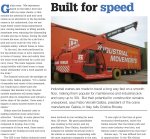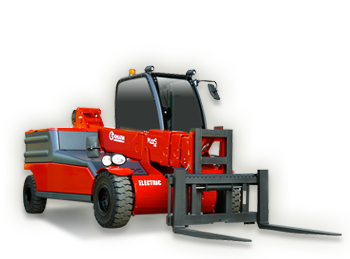15/02/2012
Built for Speed

G alizia says, “My experience based on the talks I have had with my major clients, is that actually the potential of pick and carry cranes as an alternative to the big mobile cranes is not understood, thus we see huge diesel cranes doing maintenance jobs, moving machinery or lifting moulds, sometimes even requiring the dismantling of walls and due to fumes, forcing the staff to leave the area: all this for a job that a pick and carry could do very well, in complete safety, without fumes or noise. “In the end, the work performed by the big mobile crane is more expensive in terms of money, time and safety than the same work performed by a pick and carry crane. The same happens when using forklifts with fixed boom or large diesel telehandler with a hook applied on the forks.” The financial crisis puts the spotlight on
these costs, Galizia explains. “It’s a matter of mentality and vision of the investment, but I think that in these times the company that decides to buy the most suitable machinery will obtain higher growth than its competitors and will get a better share of the market. I have seen it happen in many success stories of our clients.“ Galizia says the financial crisis is making industrial crane rental more attractive. “Actually, in some places the crisis increased requests for hiring compared to buying, due to the uncertainty of future work. Some rental companies are buying our pick and carry crane to rent.” The G20 is one Galizia industrial crane used for both industrial maintenance and construction. “One of our most popular cranes is the 2t G20 for industrial maintenance, coupled with suction systems for glass laying, used in the building of skyscrapers(courtain wall), in removing moulds and materials from industrial machinery, and then the 15t G150, our other strong point. “Together with the most recent F200, these cranes are very much in demand from the companies specialised in machinery removal and more generally in lifting large loads in narrow spaces.” Galizia’s industrial crane business has a long lineage in Italy. “Our family has been involved in iron working for more than 120 years. My great grandfather was working in this sector, and my grandfather, Piero Galizia, founded the company for metallic structural work in the sixties or seventies, cooperating with the most important companies in the area. “At the end of the eighties we started design and building pick and carry cranes, and are still producing overhead cranes and booms for concrete on behalf of third parties, as well as cutting plant for plates, machines for glass processing, and special metallic structural works. Galizia explains why Italy is the heart of the industrial crane industry. “After World War II many companies started to build cranes of different types, sometimes
in a basic way using abandoned military trucks to help the post war reconstruction, and afterwards in the ensuing economic boom they began to design and build many other kinds of cranes.
“It was right at that time of great economical development, called 'the Italian miracle' that the Italian pick and
carry crane industry was born, and Galizia cranes originated from that time.” Galizia says, “It was difficult but rich in opportunities. In the '80s Galizia bought an Italian manufacturer of pick and carry cranes,that had always had the aim of building very compact and handy cranes and was already producing mobile electric cranes.” Galizia’s cranes have spread through the EU, becoming popular in Belgium, and now reach as far as South America and Russia. “Our best markets, where we sell most apart from Italy, are France, Belgium, Holland, United Kingdom and German,” Galizia says. “We are also delivering some cranes in the US, South America, Pacific area and Russia.


